Tickets, calls, faulty equipment, people complaining… IT support moves at supersonic speed and, if your IT professionals have to manage everything with, say, Outlook, your company may be losing a lot of money.
Pair an email client with the high wages typical for the industry and you’ll get yourself in a “throwing money down the drain” situation. Resolving a single tech support case can cost anywhere between $2.93 and $49.69 and, if you offer tiered IT support, you can expect the expense to triple every time an issue is escalated.
In short, it’s best to help your IT support staff to be as productive as possible. Since you’re reading this article, you’re probably aware that the solution to this problem is an IT ticketing system. It is true. Such software can save up to 670 working hours per year.
Generally speaking, what an IT support ticket system does is to automate manual tasks and help IT staff manage the lifecycle of each request.
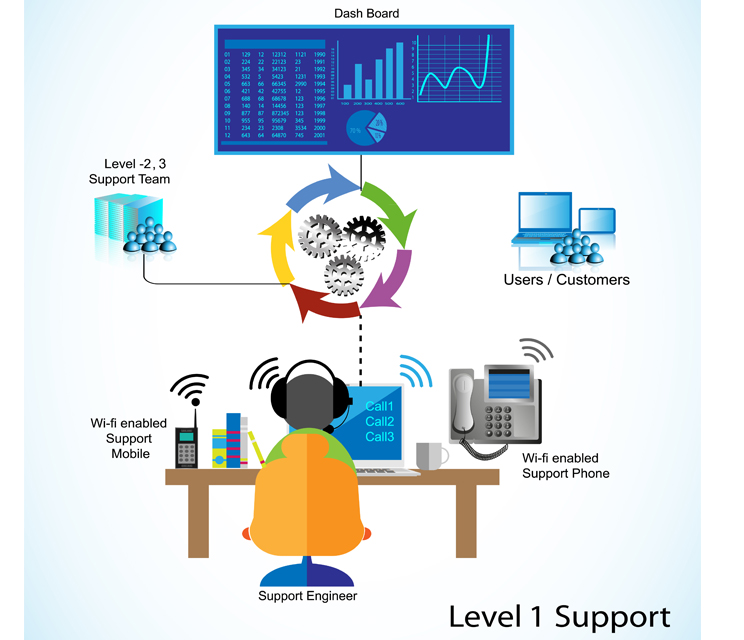
As the name suggests, ticket management is at the heart of an IT support ticket system. The system creates a ticket each time a new case is submitted, appending all relevant customer and incident data to it. Some systems also have advanced tools for asset management, IT change management, network diagnostics, problem and incident management, etc.
Note that the terms “IT help desk” and “IT service desk” can sometimes be used interchangeably even though, strictly speaking, they are two separate entities. Unlike the help desk, the service desk puts an emphasis on the users or, as the ITIL framework defined it, a service desk is “the point of communication between the service provider and all its users.” By contrast, when IT help desks first appeared in the 1980s, they were simply a means of reporting and resolving incidents on an ad-hoc basis.
The terminology gets even more confusing when your IT department doubles as a customer service department. Fortunately, most IT ticketing software can be used for both employee support and customer support. So, you can get away with using the wrong term.
Below, we'll discuss what features you should look for when choosing a help desk ticketing system as well as best practices to help you with implementing one. However, if you're short on time, you can just skip to the list of the best SaaS IT ticketing systems available as well as the best open-source helpdesk ticketing systems in 2023.
SaaS Help Desk Systems
- Spiceworks
- HubSpot
- ServiceNow
- ConnectWise
- SolarWinds Web Help Desk
- Jira Service Desk
- Jitbit
- Zendesk
- Freshdesk
- HappyFox
- Helpshift
Open-Source Help Desk Systems
We’ll review all of these in detail but, first, let’s talk about the main considerations when choosing an IT support ticket system.
IT Ticketing System Features: What to Look For
When looking for a helpdesk ticketing system, it's important to consider both your customer's needs and your agents’ workflow. Not all systems offer the full set of features and you may end up using a combination of tools to achieve the desired results.
In general, here’s what to look for when choosing IT ticketing software.
1. Multi-Channel Support
The ability to manage customer support requests from multiple channels, including email, phone, and social media, to ensure that all requests are addressed in a timely manner. With multi-channel support, businesses can provide customers with a range of options for reaching out for help, and can ensure that all requests are captured and addressed in a timely manner.
If you want to take it one step further, you may also want to consider looking into omnichannel so you can provide a seamless and integrated experience for customers across all channels. With omnichannel support, businesses can provide customers with a consistent experience, regardless of which channel they use to contact support. For example, a customer may start a support conversation via email, then switch to chat, and then switch to phone, and all of their interactions will be seamlessly tracked and integrated into a single ticket.
2. Self-Service Portal
You want to make use of a self-service portal for both customers and your helpdesk agents. The reason being:
- For customers. By offering a customer self-service portal, you'll allow your customers to troubleshoot common problems, which means less lower-priority tickets for your helpdesk ticketing system and agents.
- For your helpdesk agents. By making use of a knowledge management portal you allow agents to find answers quickly when they're working to help customers.
One of the most common self-service options that you can provide is through knowledge base software.
External knowledge base
An external knowledge base creates a rare win-win-win (yes, that’s a triple win) situation for customer support. Customers gladly resolve issues themselves which reduces ticket volume and your company’s overall support costs.
Among other things, you can use an external knowledge base to publish customer FAQs, product and service updates, and troubleshooting guides. Customers can browse by category or search the knowledge base which helps you deflect ticket creation while keeping them happy—they find the information they need instantly.
Here’s an example.
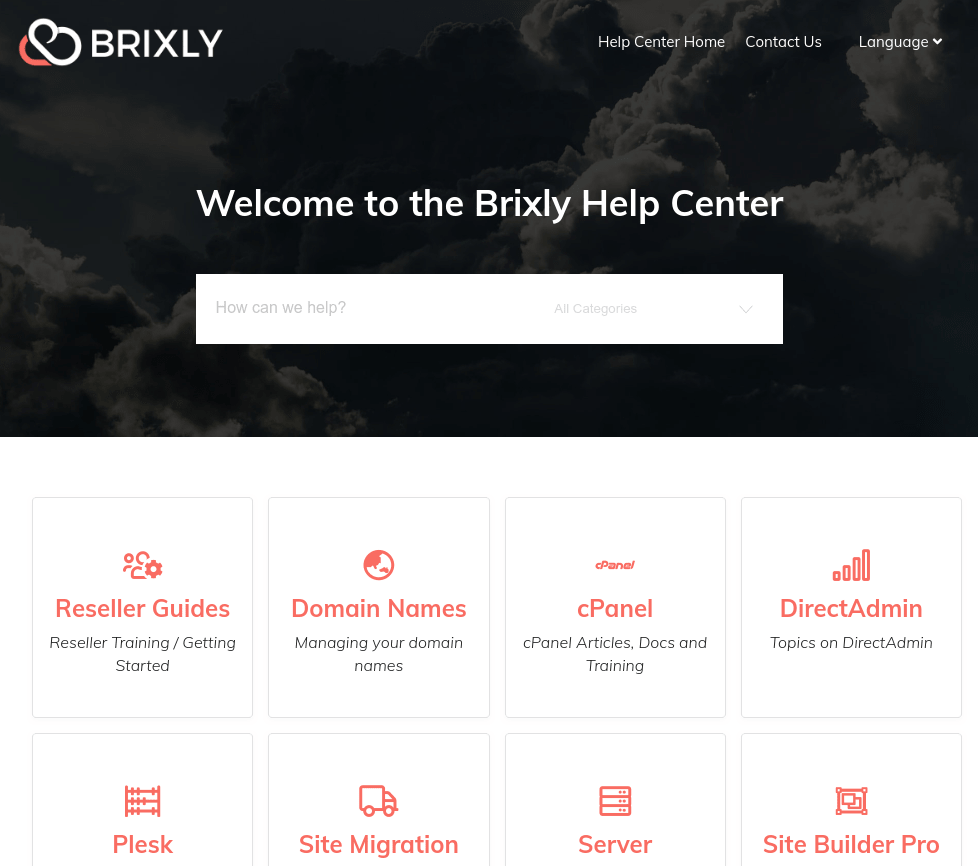
Internal knowledge base
An internal knowledge base helps your IT team work more efficiently because it enables employees to serve themselves. Your busy users will appreciate the ability to find the answers and instructions they need without having to wait.
An internal knowledge base can also be extremely useful to agents when dealing with service requests. It can store SOPs for handling requests as well as how-to’s, technical documentation, and best practices.
Not all helpdesk ticket software comes with a knowledge base but you may use a third-party solution.
3. Unified Smart Inbox
One of the crucial features of an IT ticketing system is the ability to create helpdesk tickets from various sources such as email, live chat, social media, phone calls, etc. If there is a single dashboard to view and manage all incoming tickets, your team will be more productive.
Here’s what a unified inbox should enable you to do:
- Create tickets manually
- Use quick pre-populated templates for common issues
- Send an automatic response to the end-user when she submits an issue, giving her the ability to reply
- Attach files
- Keep all past conversations in the same ticket to provide context
- Prevent two agents from responding to the same ticket at the same time (collision detection)
- Enable agents to collaborate on a ticket, e.g. by leaving internal notes
4. Automation
Most ticketing systems allow you to define triggers and rules to change ticket status, priority, category, and other ticket attributes automatically. Some even give you the ability to define custom workflows, eliminating the larger portion of manual work. Here’s how this works in practice.
Let’s suppose that your ticketing system software lets you set up rules to auto-triage and auto-prioritize tickets based on the email address, subject line, ticket category, and other conditions. You can create a rule to tag all issues coming from a specific email (an important client or a C-level executive) and assign the tickets to your most experienced IT support professionals.
Automation is especially useful to companies that need to tie a custom set of products and services to each customer (e.g. MSRs).
5. Security
Customer details are often attached to service tickets, passwords are sent back and forth, and so on. Ticketing system software should be able to protect your sensitive data.
Some companies opt for on-premise installations to eliminate all potential threats. Some prefer cloud-based ticketing systems. There are benefits and drawbacks to both but security is a concern in all cases.
Here are some important security features to look for in an IT helpdesk:
- IP restrictions to ensure only your staff can log in to the back end
- Message encryption to protect sensitive data
- Access control to define user groups and privileges within your organization
- Virus scanning to ensure no harmful file attachments can be sent
- SSL URL encryption for cloud-based systems
6. Incident and Problem Management
Incident management is like firefighting. First, the incident is identified and logged, then it’s diagnosed and, finally, it’s solved as fast as possible.
If you look at the incident management lifecycle below, you’ll notice that the features you need are available in almost all ticket management software.
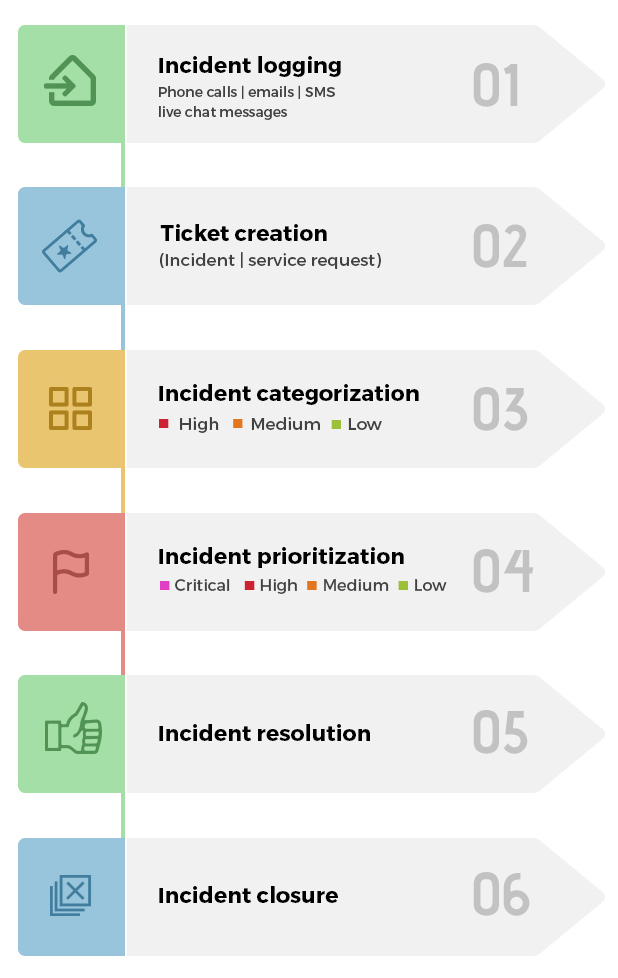
(Source)
Problem management can be a bit more tricky, though. It’s about understanding the root cause that has lead to one or more incidents and taking action to prevent further incidents. If you need problem management, you need an IT support system that allows you to:
- Perform incident analysis and identify trends
- Detect duplicate and recurring issues
- Identify future risks related to the current incident
- Analyze information from external sources like suppliers, partners, the internal developer team, etc.
7. Insights
Speed is extremely important in IT support which is why most teams have SLAs (Service Level Agreements) they have to stick to. That’s why analytics and insights are a crucial aspect of ticketing system software.
The best ticketing system will help you understand immediately how your team is performing against your SLAs. It will provide you with real-time data regarding agent performance such as tickets closed, the average handle time to resolve issues, and so on.
In addition, ticketing system software should also enable you to collect customer feedback and measure customer satisfaction—be it through NPS surveys, CSAT surveys, or some other method.
8. Integrations
If you work in a large organization, integrations with other software will be a chief consideration in your search for a service desk ticketing system. Here are a few cases where this might be necessary:
- Integration with your CRM can give you a better view of your customers—their buying history, web browsing activity, their likes and interests, and more. Armed with such insight, your IT support team will be able to provide personalized support.
- Integration with your IT asset management system can help you identify faulty equipment that needs to be repaired or replaced, enabling you to improve your problem management.
- Integration with your issue tracking system can help you prioritize software bug fixes.
9. Scalability
When choosing service tickets software, you might want to consider the ability to scale.
Will this work if your company grows?
How much will it cost if your team doubles or triples?
Some of the top scalability concerns include the maximum number of user accounts, data storage capability, number of teams and customers you can manage on the same platform. Note how the pricing changes as your team grows.
10. Analytics and Reporting
Reporting and analytics capabilities are essential for businesses that want to track and optimize their customer support operations. With the right reporting and analytics tools, businesses can gain valuable insight into key performance metrics, such as ticket volume, response time, resolution time, and customer satisfaction.
Some of the top reporting and analytics features to look for in a helpdesk ticketing system include:
- The ability to create custom reports that capture the specific metrics and data points that matter most to your business
- Real-time dashboards to view key performance metrics in real-time, in a centralized dashboard that provides an at-a-glance view of how support operations are performing
- Advanced analytics such as predictive analytics, machine learning, and sentiment analysis, that can provide deeper insights into customer behavior and support operations
- The ability to track historical data over time, enabling businesses to identify trends and patterns in customer support operations and make data-driven decisions about how to optimize those operations.
11. Chatbots
In general, chatbots are becoming an increasingly popular and integral feature to look out for as they can provide fast and efficient responses to common customer inquiries and support requests.
Moreover, with the release of AI natural language processing (NLP) bots like ChatGPT, it's becoming essential to find help desk software that either comes with an AI NLP chatbot or easily integrates with one. Since AI NLP bots can understand and interpret the meaning behind customer inquiries and support requests, they will allow businesses to provide more accurate and personalized responses to customer inquiries. This is particularly useful for businesses that receive a high volume of customer support requests, as it enables them to provide fast and accurate support at scale.
Some of the benefits of integrating an AI-powered chatbot with a helpdesk ticketing system include:
- 24/7 availability
- Fast and efficient responses to common support requests, such as FAQs and account inquiries, freeing up support agents to focus on more complex issues
- Consistent support experience across all channels
- Improved customer satisfaction due to the ability of providing fast and efficient support
12. Compliance
Last but not least, you have to think about regulations and standards. If you work for a healthcare organization, you’ll need a HIPAA compliant help desk. If your company has to conform to ITIL, you’ll need a help desk system that meets the ITIL requirements.
So, it’s a good idea to take note of any standards and regulations your organization has to adhere to and add them to your IT ticketing system checklist.
Before reviewing the best ticketing systems on the market, let’s outline some best practices.
Helpdesk Ticket System Best Practices
- Have a support portal: Encourage self-service by publishing lots of content in your external knowledge base. Make sure it’s easy to submit a ticket and there is a smart search functionality that enables customers to find all information relevant to their case.
- Categorize tickets on submission: To save time and reduce manual work, create automation rules that assign a specific type of issue to a specific agent or department.
- Define SLAs and stick to them: Service Level Agreements (SLAs) help you set expectations with users as well as measure agent performance. To keep up with your SLAs, make sure you have enough agents to handle all support requests and your IT helpdesk software has enough capacity to support your team.
- Let your system manage handoffs: Customers expect companies to know “know their contact, product and service information or history”. Make sure agents receive all the necessary background information to resolve tickets.
- Create specialized teams: Instead of having all of your IT staff running from network infrastructure to hardware support, to system change requests, you can set up specialized teams that will work on sets of related tasks. This reduces stress and helps your agents stay focused.
- Perform customer satisfaction surveys regularly: Metrics give you lots of insights but feedback from your customers is what helps you see the finer details in the big picture.
The Best SaaS Helpdesk Ticketing Systems in 2023
Today's fast-paced business environment demands a reliable and efficient IT ticketing system that can seamlessly manage customer support requests. That's where Software-as-a-Service (SaaS) ticketing systems excel as they provide businesses with an easy-to-use and highly scalable solution for tracking and resolving customer issues from a centralized platform.
Below, we'll discuss the top reviewed SaaS ticketing systems available in 2023 as well as how they can help businesses streamline their customer support operations.
1. Spiceworks
Spiceworks is a free, cloud-based helpdesk ticketing system that provides businesses with a range of tools and features for managing customer support requests. Depending on our needs, you can extend it with a large variety of IT support apps for tasks and processes like inventory management, remote support and network monitoring.
The software is designed to help businesses improve the speed and efficiency of their support operations, while also providing a seamless and personalized support experience for customers.. For those who want to connect with peers and exchange expertise, there is the Spiceworks community which is quite large and popular among sysadmins, network engineers and other IT professionals.
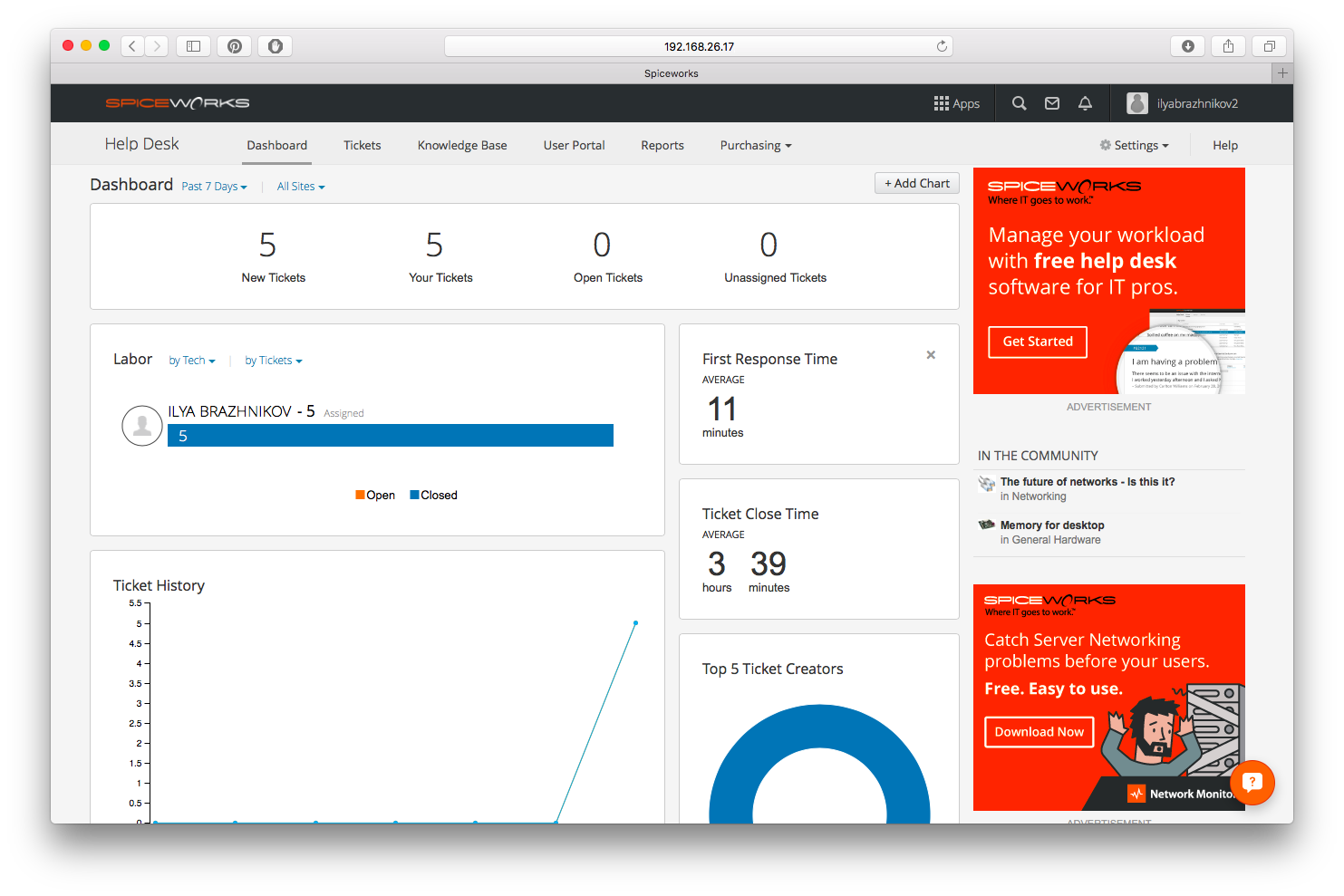 (Source)
(Source)
Spiceworks at a glance:
- Spiceworks offers advanced automation features, such as auto-assigning tickets and sending auto-replies, to help businesses handle common support requests quickly and efficiently.
- Ticket submission forms can be customized for various scenarios
- The ability to offer remote support by initiating a secure remote session directly from the help desk ticket
- Free, customizable helpdesk ticketing software
Pros:
- Free, yet still feature-rich
- It offers automated inventory tracking and reporting
- User-friendly interface and easy to implement due to its cloud based system
- It has a large online community of IT professionals and vendors
Cons:
- It lacks some advanced features and customization options that you can find in some of the other SaaS help desk solutions on this list
- It may not scale well for larger IT departments or complex workflows
- Because it's free, you may be shown ads or sponsored content which can be annoying when trying to resolve a customer ticket
- Some users of Spiceworks have complained about performance issues
2. HubSpot
HubSpot's Help Desk tools let you log, organize, and track customer support tickets all on one dashboard that’s accessible to your entire team. Reps can view all communication made on the ticket and oversee the case's progress throughout the entire troubleshooting process. Tickets are also linked to customer records, making it easier for customer service reps to reference past engagements with the company. With the Help Desk feature, HubSpot will automatically create a ticket when a customer fills out a form, sends an email, or reaches out through live chat.
Additionally, HubSpot provides ticket analytics that customer service managers can use to track their team's performance. This data includes important metrics like agent response time, ticket volume, and more which indicate if a team is meeting customer demand. If not, management can investigate individual rep workflow and identify key roadblocks that are preventing the team from achieving business goals.
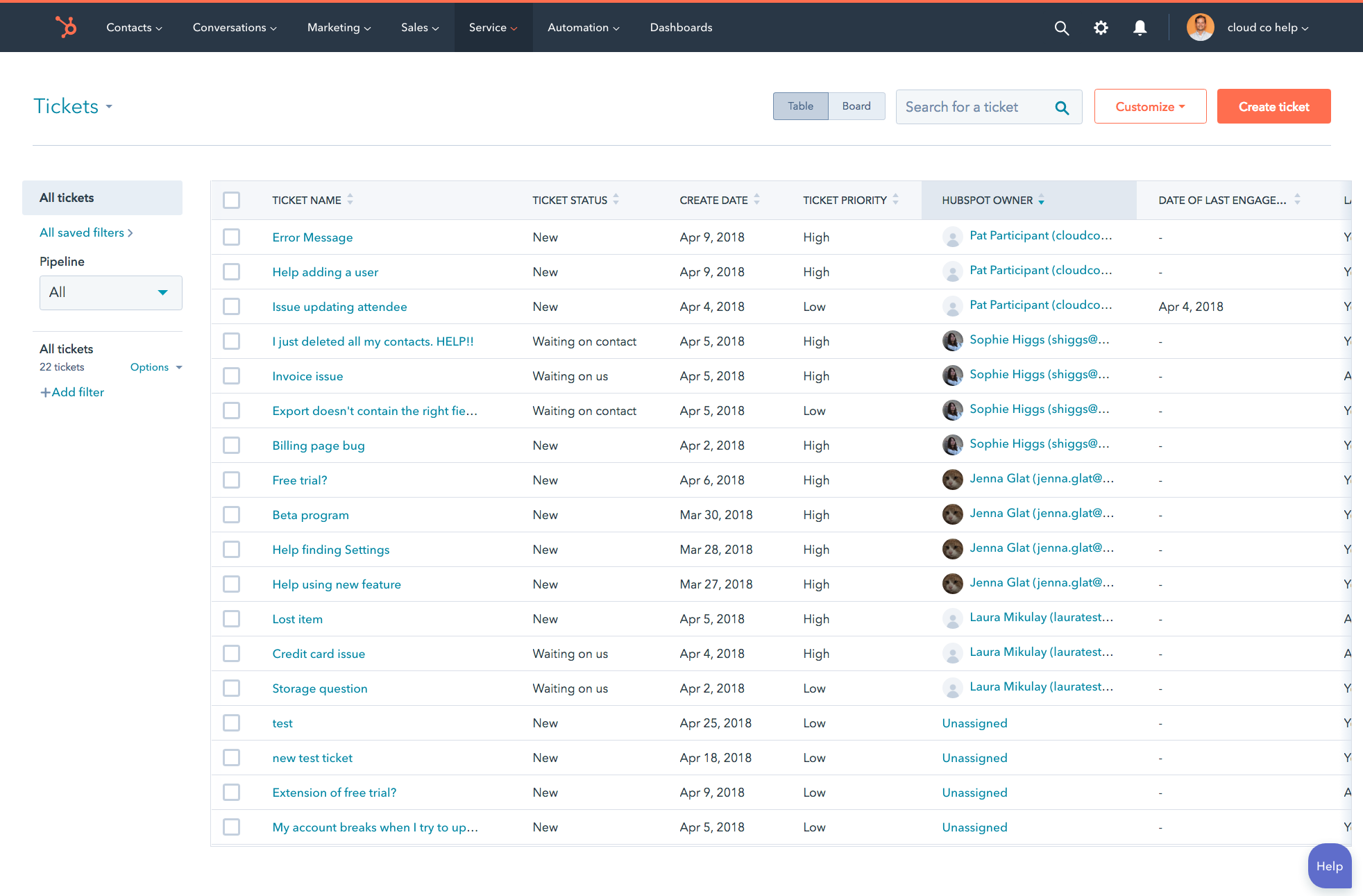
(Source)
HubSpot Help Desk & IT Ticketing solution at a glance:
- Shared inbox to organize and prioritize customer service requests
- Ability to integrate with HubSpot's CRM which gives a more complete view of customers in every interaction
- Automated ticket creation and routing, data entry into CRM, and issue escalation to provide efficient and timely customer service
- Ticket owner and stage assignment to help teams prioritize their workload and triage incoming tickets effectively
- Dashboards and built-in analytics to identify customer service trends and measure key customer experience metrics
Pros:
- It offers powerful marketing automation and content creation tools
- Contextualized conversations with tags, notes, and comments provide a complete view of customer history
- Integration with other HubSpot tools like their CRM, marketing, and sales solutions making this an all-in-one platform
- Free plan available
Cons:
- Limited customization options compared to other advanced helpdesk ticketing systems
- Pricing plans can be expensive for businesses with larger support teams or higher ticket volumes
3. ServiceNow
ServiceNow is an enterprise ticketing system that goes beyond simple incident logging. This platform intends to bring all IT operations in one place—from ITSM to governance and DevOps.
The main focus of this software is efficiency.
For example, ServiceNow enables you to consolidate all of your IT systems, networks and software in a centralized dashboard. You can track custom metrics and create your own workflows for internal users, customers and IT staff. You can even use it as a task management system.
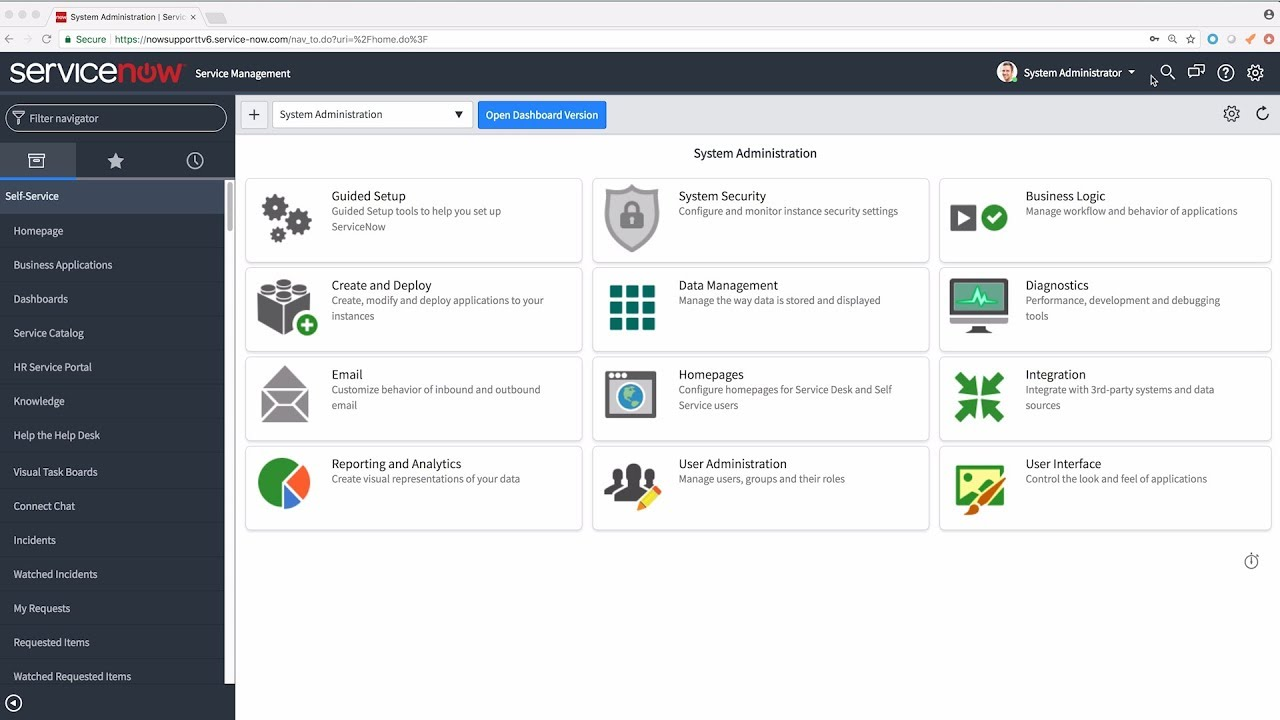
(Source)
ServiceNow at a glance:
- Incident and problem management features
- Asset and configuration management
- Interactive dashboards with custom metrics
- Your own workflows for the full range of IT processes, including customer service, ITSM, asset management, and so on.
- Marketplace with a large number of extensions and apps
Interested in alternatives? If you're intrigued by what ServiceNow has to offer but are still weighing your options, then you may want to check out our recent post on the best ServiceNow alternatives.
4. ConnectWise
ConnectWise is more than IT ticketing software. It’s a full-blown business process automation platform designed for companies that need to manage various support workflows under the same digital roof. Besides a ticketing system, the platform has many other capabilities including project management, time tracking, reporting, billing and procurement.
If you need additional functionality, you can customize ConnectWise with one of the 300+ third-party integrations. The system’s flexible contract management helps you handle multiple service contracts with ease.
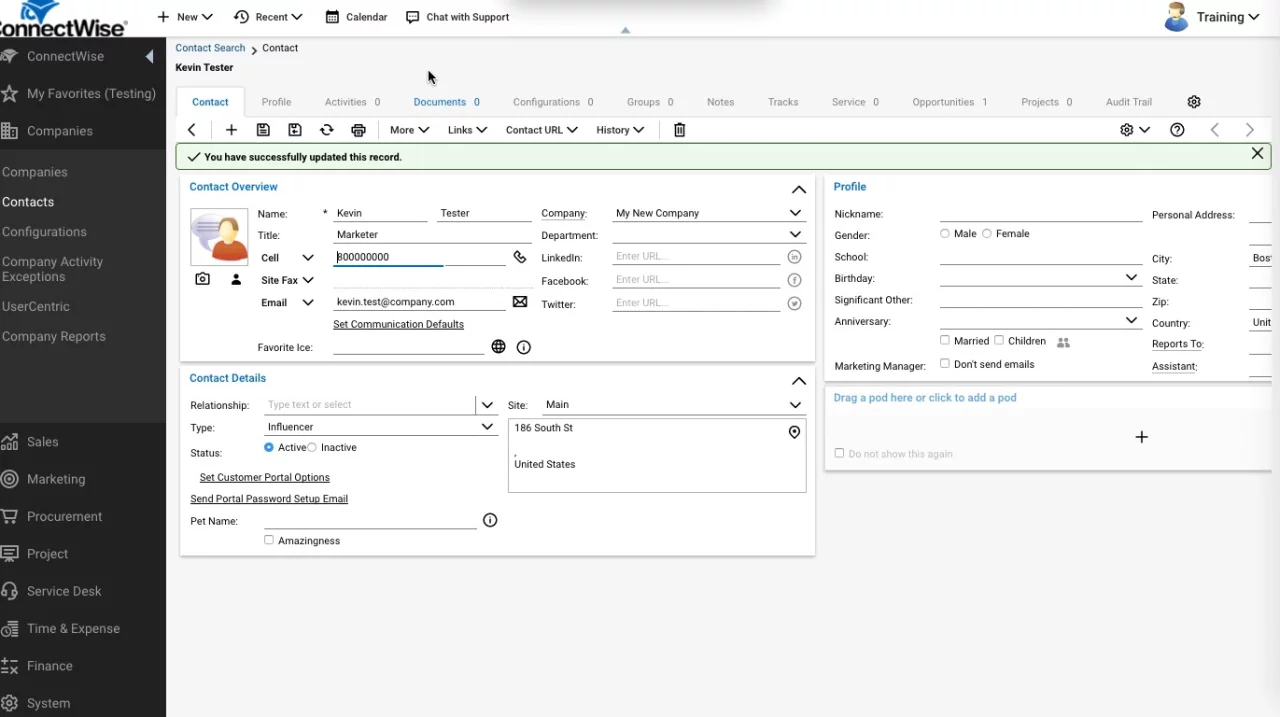
(Source)
ConnectWise at a glance:
- Help desk and ticketing system
- Timesheets, dashboards and reporting
- Billing, procurement and dispatch
- Open API and 300+ Integrations
5. SolarWinds Web Help Desk
This review is about SolarWinds Web Help Desk which is designed to handle customer requests and asset management only. If you need a help desk ticketing system for employee support, there is another SolarWinds program for that called Service Desk.
That being said, Web Help Desk is a downloadable program that enables you to manage support tickets, IT assets and change management requests. One of the features that stands out is “SLA breach approaching”—it allows you to set up SLA alerts. For example: “If a ticket hasn’t been updated for 45 minutes, notify the group manager.”

(Source)
SolarWinds Web Help Desk at a glance:
- Ticket linking to manage related tickets more easily
- Native integration with Active Directory and LDAP
- Configure automated feedback surveys
- Integrate with 3rd-party tools for IT asset management
6. Jira Service Desk
Unlike SolarWinds, Jira Service Desk is a helpdesk ticketing system suitable for both ITSM and customer service. Since it has been built on the same platform, this solution connects seamlessly with the company’s popular project management system—Jira Software.
Jira Service Desk can be extended using 350+ third-party addons that include tools for asset management, surveys, CRM, and many other IT-related tasks. This system comes with powerful automation features that enable you to streamline tasks like ticket routing and severity 1 notifications.
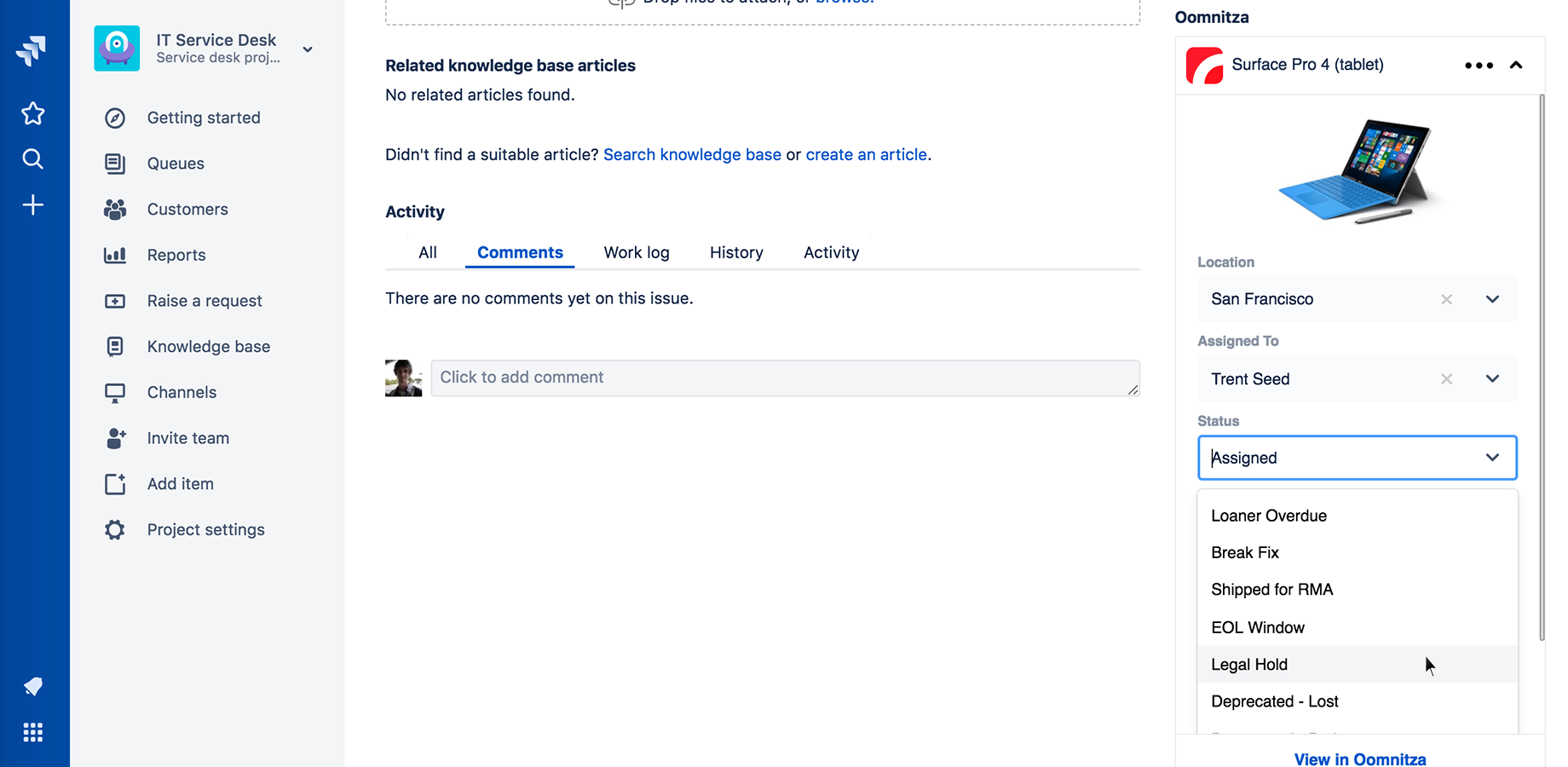 (Source)
(Source)
Jira Service Desk at a glance:
- Repetitive task automation
- Service Level Agreements (SLAs)
- 350+ add-ons on the Atlassian Marketplace
- Customer satisfaction reporting (CSAT)
7. Jitbit
Offering both cloud and self-hosted solutions, JitBit is focused on simplicity. This doesn’t mean that this is helpdesk ticket software is limited, though. Under the minimalistic interface, you will find powerful automation triggers that allow you to send automatic replies, assign technicians to tickets and set ticket due dates.
Jitbit features built-in integrations with tools like Slack, Jira, and Github. You can also connect it to Zapier (which is a gateway to 500+ more apps) or use the REST API to build your own custom integrations.
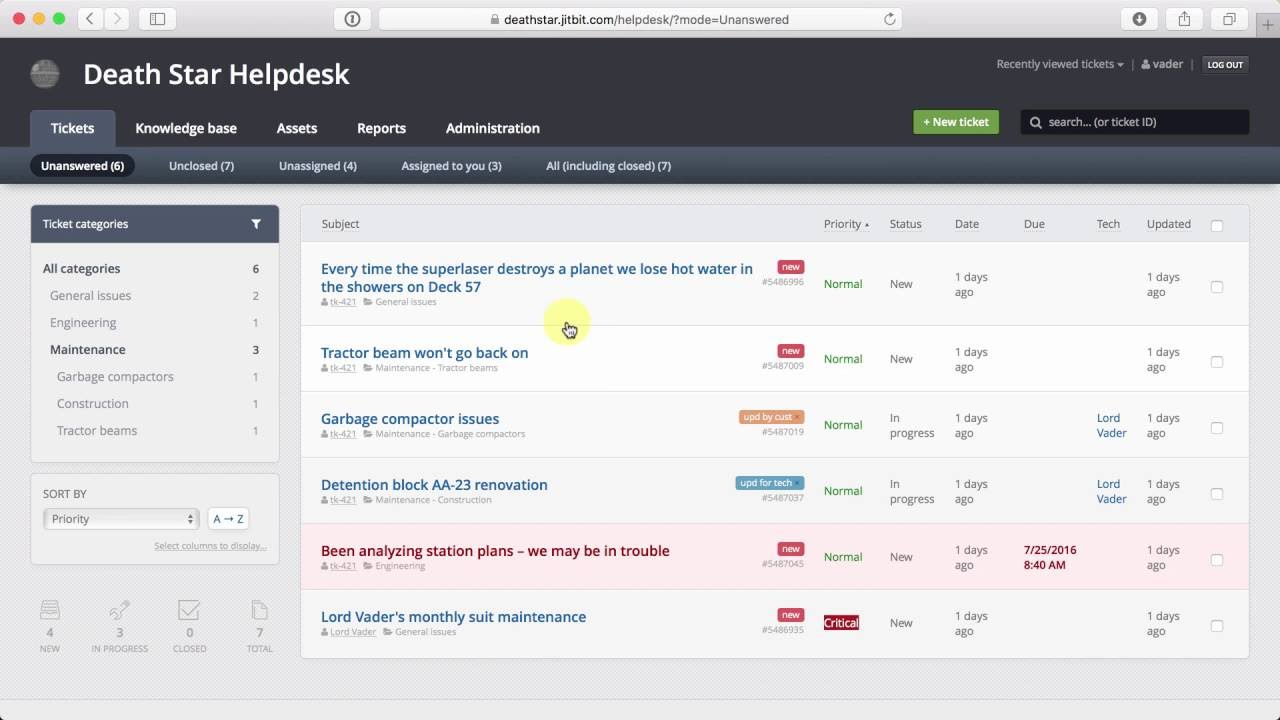
(Source)
Jitbit at a glance:
- Help desk automation
- Asset management
- Mobile help desk apps
- SSL Encryption
8. Zendesk Support
Zendesk Support is an IT ticketing solution part of the Zendesk suite. Designed for general-purpose customer service, it doesn’t include IT-specific features such as change and asset management.
On the flip side, this system is great at multi-channel support—tickets can be created from a myriad of sources, including social media sites.
One of Zendesk’s strengths is the implementation of rules. For example, agents can trigger a specific automated workflow when there’s a change in one of the ticket’s attributes. Zendesk’s “Views” can also come in handy as they allow you to filter tickets based on certain criteria.
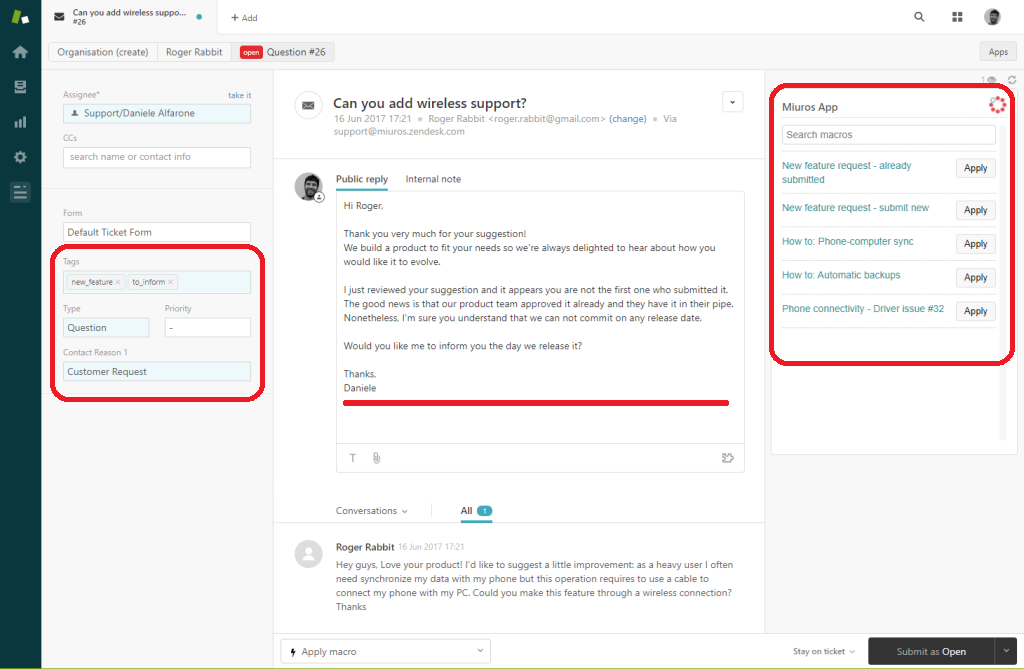
(Source)
Zendesk at a glance:
- Customizable views and ticket expiration times
- Customizable reporting dashboard with flexible queries that allow you to create any report you like
- Cost per agent can grow to $200 in large teams
Interested in alternatives? If Zendesk has caught your attention but you’re on the lookout for different functionalities or want to explore a broader spectrum of options, then check out our post on the best Zendesk alternatives.
9. Freshdesk
Freshdesk is a cloud-based ticketing support system that has all the necessary IT support features in one place, making it a popular Zendesk alternative. The functionality varies based on your plan but all plans include ticket management, team collaboration, social ticketing, and reporting.
One especially helpful Freshdesk feature is the contact management hub where contacts and companies are associated with tickets, making it easier to manage communication. Agents and managers can easily filter outstanding tickets by various criteria to ensure all issues are addressed on time.
Note that Freshdesk is not suitable for ITSM. The company offers another tool for that called Fresh Service.
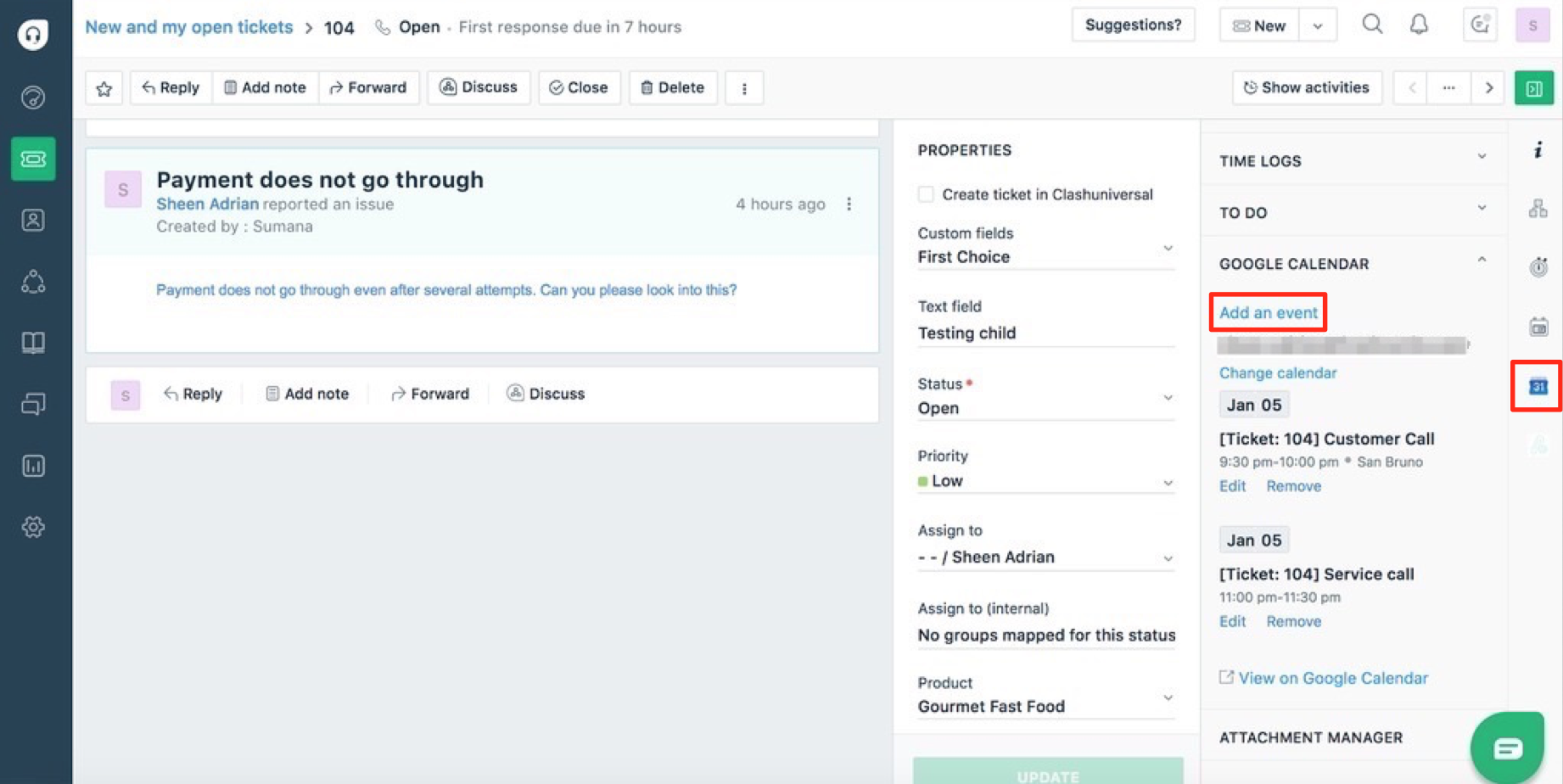
(Source)
Freshdesk at a glance:
- Automation and skill-based assignment in paid plans
- Team dashboards enable you to monitor important metrics
- “Gamification” feature to motivate agents
- Offer multichannel support via email, chat, website and social media
10. HappyFox
HappyFox is a practical and powerful help desk software that helps you reduce chaos and bring order to your customer support process. With HappyFox, you can manage support tickets from multiple channels, create self-service knowledge bases and community forums, set up SLA management and automation, and integrate with popular apps like Salesforce, Slack, and G Suite. HappyFox is a cloud-based solution that offers agent-based pricing and hosting migration assistance.
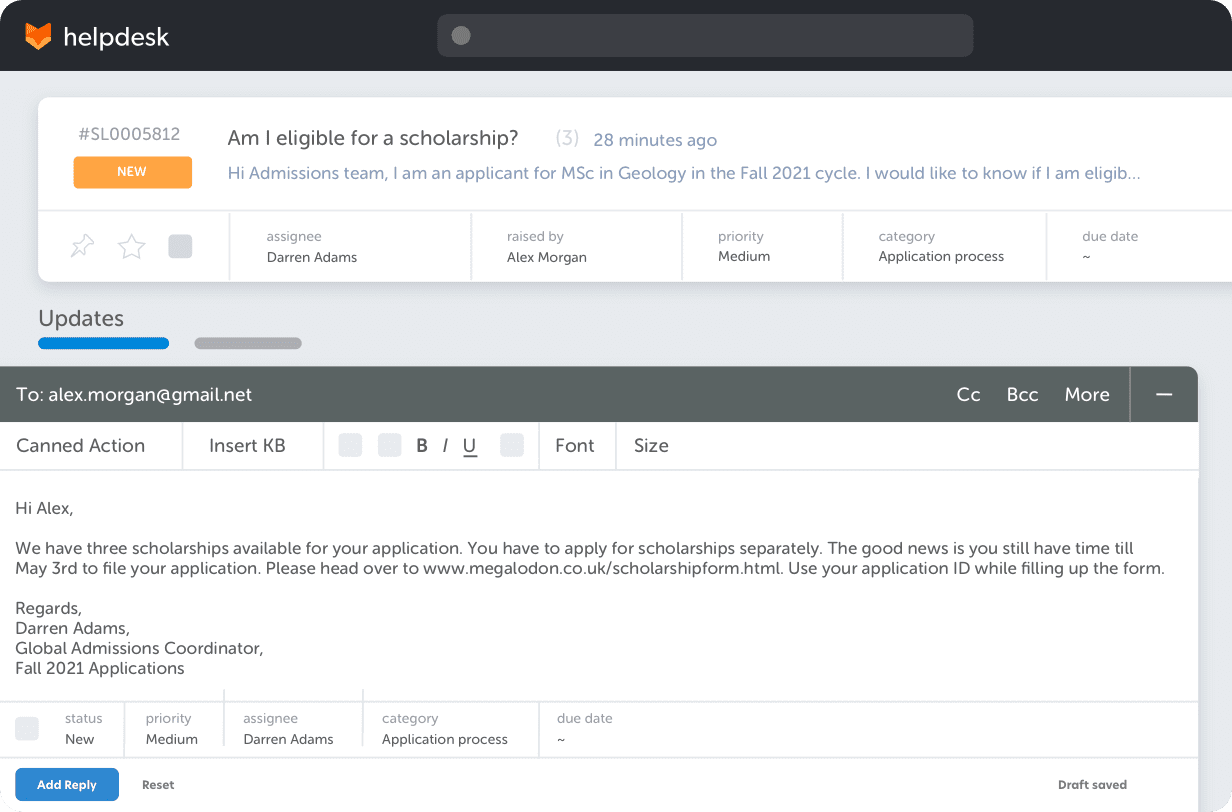
HappyFox at a glance:
- Omnichannel ticketing allows you to receive as well as respond to support tickets from email, web, phone, live chat, SMS, and social media
- SLA management enables you to define and monitor service level agreements for your tickets and ensure timely resolution
- You can automate repetitive tasks like ticket assignment, prioritization, escalation, and notifications
11. Helpshift
Helpshift is a cloud-based customer support platform that provides businesses with a range of tools and features for managing customer support requests across multiple channels, including web, email, chat, and mobile. The software is designed to help businesses improve the speed and efficiency of their support operations, while also providing a seamless and personalized support experience for customers.
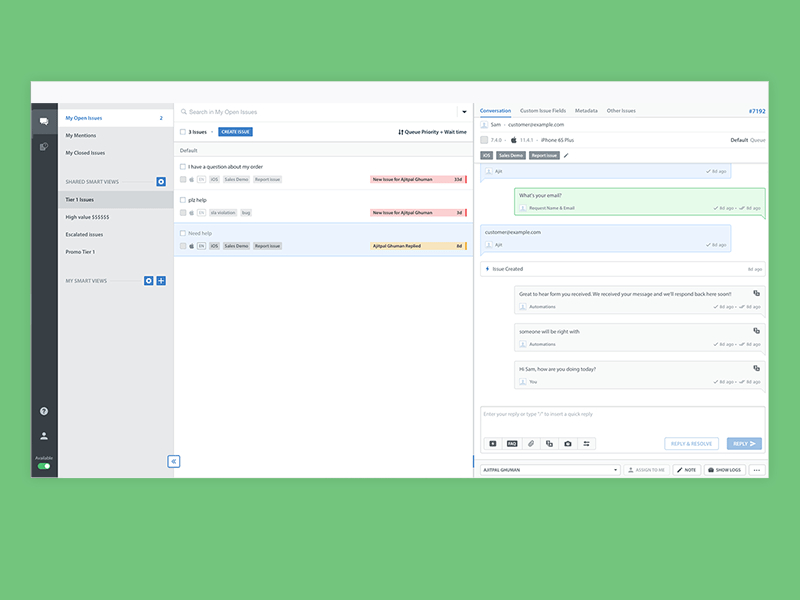
Helpshift is a scalable and secure solution that leverages AI and automation to improve customer satisfaction and retention.
Helpshift at a glance:
- You can use AI-powered chatbots to handle common queries, collect information, and route tickets to the right agents
- Self-service enables your customers to find answers on their own using FAQs, smart search, and contextual suggestions
- Integration with popular messaging apps like WhatsApp, Facebook Messenger, Apple Business Chat, and more for convenient communication with your customers
- In-app messaging, allowing businesses to provide support to customers directly within their mobile apps, without requiring them to switch to a different channel or device
The Best Open-Source Helpdesk Ticketing Systems in 2023
For businesses that prefer a more flexible and customizable solution, open-source ticketing systems provide a compelling alternative to SaaS platforms, offering greater control over the software and the ability to tailor it to specific business needs without incurring licensing fees. In this section, we'll explore some of the best open-source ticketing systems available in 2023 and how they can benefit businesses looking for a more hands-on approach to customer support management.
1. osTicket
osTicket is a support ticket system that has all the basic functionality you may need for IT support and can also be customized to your preference. You can choose between a free open-source version and a cloud-hosted version available for a monthly subscription.
One of osTicket’s main advantages is the ability to auto-triage incoming requests. You can set up custom fields, queues and forms upon ticket submission to forward each ticket to the right agent or agent group.
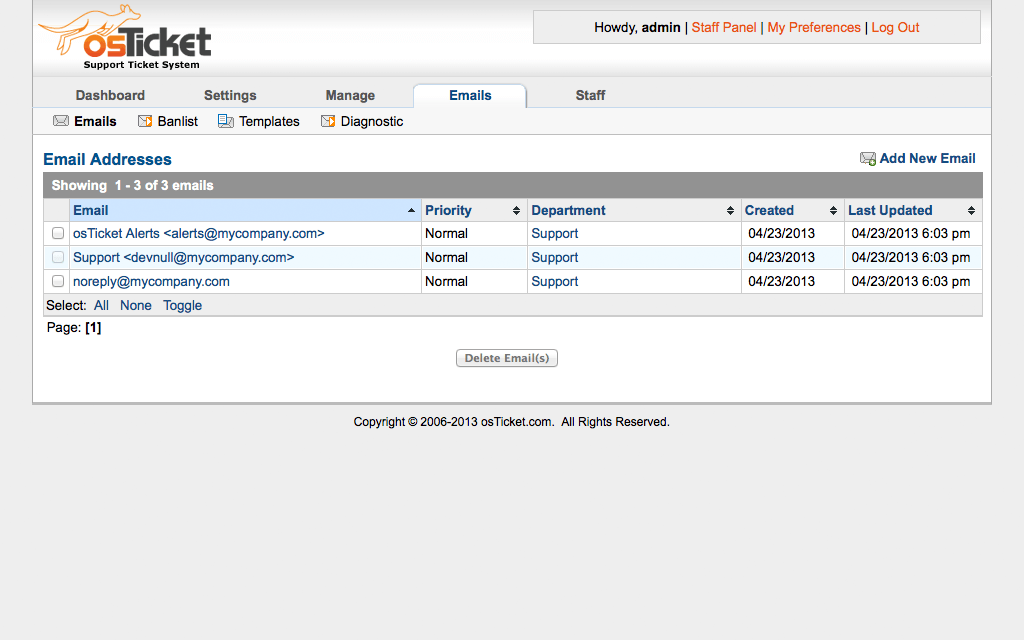
(Source)
OSticket at a glance:
- Free, cloud-hosted and enterprise versions
- Agent collision avoidance
- Rules to route incoming tickets
- Service Level Agreements
- Dashboard reports
2. Zammad
Next on our ticketing system software list is Zammad. This web-based open-source helpdesk support system enables you to provide IT service via several channels like telephone, Facebook, Twitter, chat and email.
Zammad’s ticket escalation rules and “desired deadlines” can be applied not just to tickets but also to clients and organizations, enabling you to quickly define and monitor your SLAs. One of the biggest advantages of this system is that it’s auditable—you can go back to any moment in time and see who changed what.
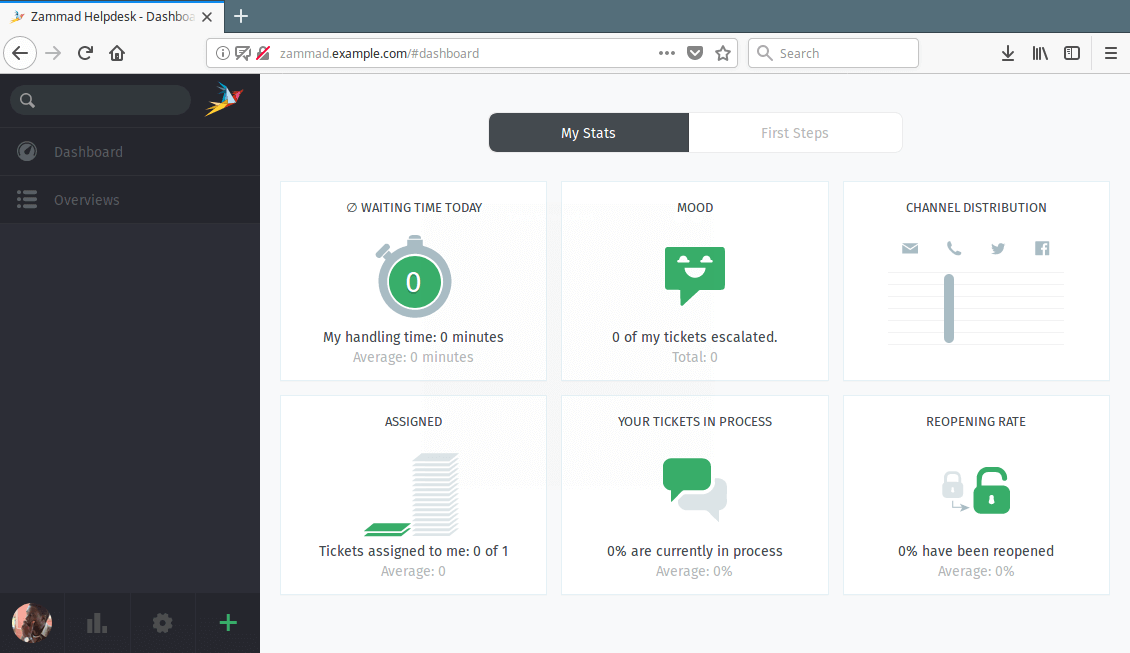
(Source)
Zammad at a glance:
- You can search both tickets and file attachments
- Autosave and collision detection
- Individual escalation rules and ticket solution time limits
3. Request Tracker
Request Tracker is a free, open-source help desk ticketing program that enables you to keep track of tickets and manage workflow processes. The web-based interface is completely responsive which means that user requests can be accessed on any device.
Request Tracker is a secure solution that comes with complete PGP support for signing, encrypting and decrypting files. Unlike the other tools on this list, Request Tracker doesn’t boast a great UI. The interface may look outdated to some users.
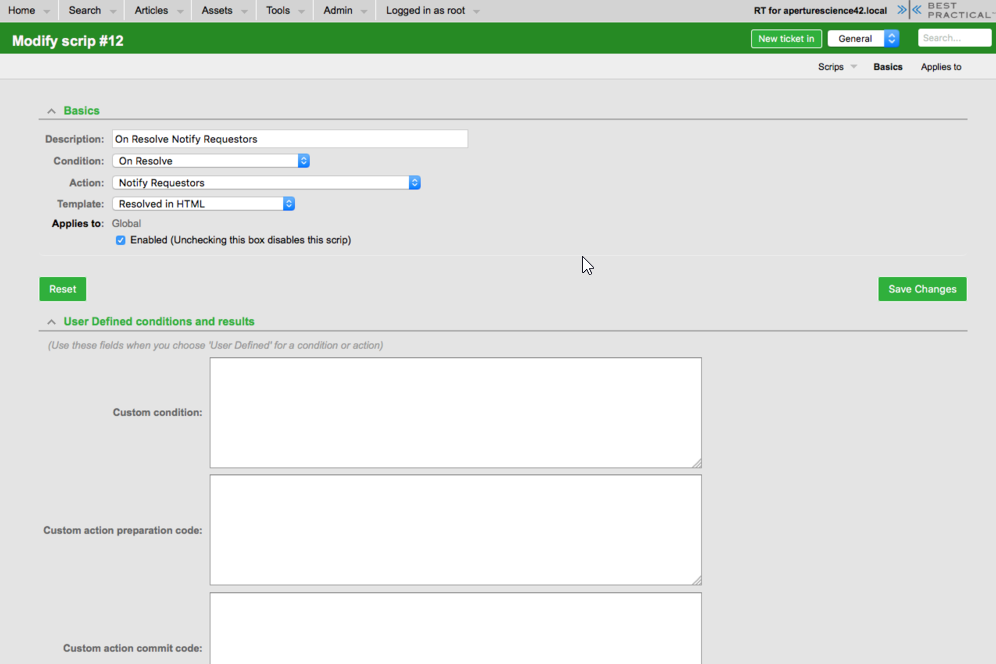
(Source)
Request Tracker at a glance:
- Robust workflow management, including customizable queues, statuses, and templates, to help businesses automate their support operations
- Highly configurable automation capabilities, including ticket routing, escalation, and notifications, to help businesses streamline their support workflows.
- Open-source codebase with an active community of developers and users, providing businesses with the ability to customize and extend the software to meet their specific needs
- Paid support plans can be purchase
4. OTRS
OTRS is a highly flexible open-source ticketing system that allows businesses to manage their customer support requests through a single, centralized platform. With OTRS, businesses can easily customize the software to fit their specific needs, whether it's configuring workflows, creating custom fields, or setting up notifications.
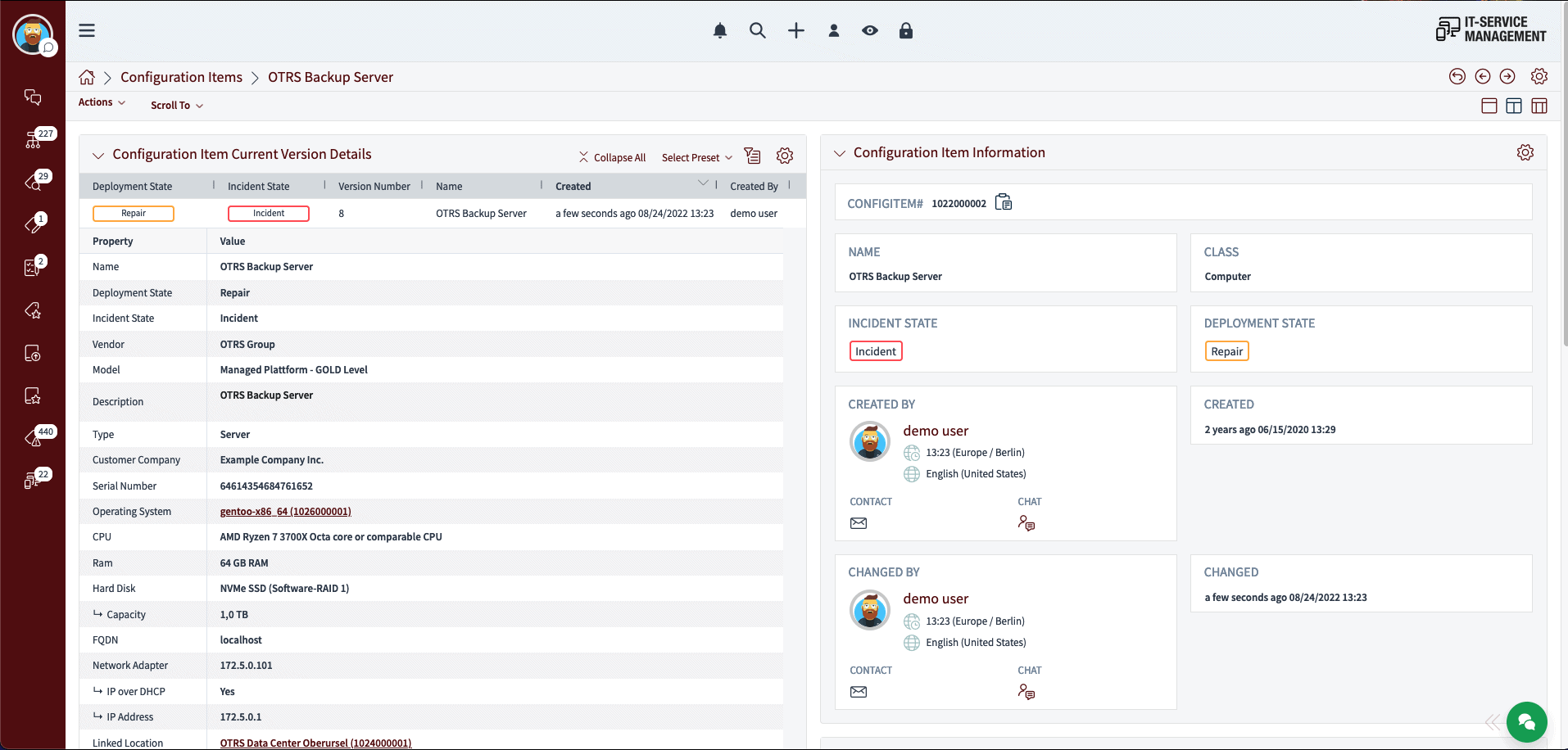
Additionally, OTRS offers advanced reporting features that allow businesses to track metrics like ticket volume, response time, and customer satisfaction.
OTRS at a glance:
- Highly customizable and flexible platform, allowing businesses to tailor the software to their specific needs
- Advanced ticket management capabilities, including ticket creation, assignment, tracking, and escalation
- Built-in automation features, such as ticket routing and auto-replies, to help streamline customer support operations
- Robust reporting capabilities, including real-time analytics and custom report creation, to help businesses track key performance metrics
- Multi-channel support, allowing businesses to manage customer requests from multiple channels, including email, phone, and social media
All-in-One IT Helpdesk Ticketing System or Specialized Solutions?
Some of the solutions we suggested can handle just about any IT support task—they give you the ability to manage tickets, inventory, customer requests, and employee requests on the same platform. This can be a great option in certain cases when you don’t mind a steep learning curve or a high price tag.
However, you don’t always need an all-in-one solution. If you value simplicity, you may decide to stack several IT support programs that are best at one specific aspect of IT support.
For example, Helpjuice is a knowledge base system that is focused on providing your end-users with stellar self-service. It can work in conjunction with any of the helpdesk systems we listed above.
If you choose to pair our knowledge base software with an easy-to-use IT ticketing system, you’ll get the best of both worlds: Simple, super-fast self-service, and uncluttered agent interface.




